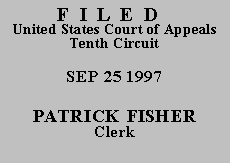

| DONALD W. VAN WINKLE,
Plaintiff-Appellant, v. JOHN J. CALLAHAN, Acting Commissioner, Social Security Administration,(*) Defendant-Appellee. |
|
Plaintiff-appellant Donald W. Van Winkle appeals the district court's judgment affirming the decision by the Commissioner of Social Security denying his applications for benefits. Because the Commissioner's decision is supported by substantial evidence, we affirm.
Plaintiff has been diagnosed with scoliosis of the lumbosacral spine. In February 1990, he injured his cervical spine in a car accident. X-rays taken at that time revealed grade 2 degenerative changes in the thoracic spine at T9-T10. After two months of chiropractic treatment, plaintiff was released to return to work with no restrictions. He returned to his job as a pipefitter's helper until it ended in October 1992. In May 1993, plaintiff applied for both disability insurance and supplemental security income benefits, alleging an inability to work after October 15, 1992, due to back pain. After a hearing, an administrative law judge (ALJ) found that although plaintiff cannot return to his former work, he is not disabled because he retains the ability to do the full range of light and sedentary work. The Appeals Council denied review, making this the final decision of the Commissioner. The district court affirmed, and this appeal followed.
We review the Commissioner's decision to determine whether his factual findings are supported by substantial evidence and whether correct legal standards were applied. See Hawkins v. Chater, 113 F.3d 1162, 1164 (10th Cir. 1997). Substantial evidence is "such relevant evidence as a reasonable mind might accept as adequate to support a conclusion." Richardson v. Perales, 402 U.S. 389, 401 (1971) (quotations omitted). We may "neither reweigh the evidence nor substitute our judgment for that of the agency." Casias v. Secretary of Health & Human Servs., 933 F.2d 799, 800 (10th Cir. 1991).
On appeal, plaintiff argues that the Commissioner's finding that plaintiff can perform the full range of light and sedentary work is unsupported by substantial evidence because there is no medical evidence plaintiff can either sit or stand on a prolonged basis. We disagree. In April 1990, plaintiff was released from treatment to "resume normal activities," with no restrictions on walking or sitting noted. Appellant's App. II at 125A. In 1993, a consultative examination revealed that plaintiff had a good range of motion in his spine and all extremities, had a good ability to walk in terms of strength, speed, stability, and safety, had no lower extremity symptoms or muscular weakness, and did not need an assistive device to ambulate. See id. at 126-132. Again, no restrictions on walking or sitting were noted. These medical findings support the Commissioner's conclusion that plaintiff can perform the standing and sitting requirements of light and sedentary work.
Moreover, even accepting plaintiff's testimony regarding his sitting and standing limitations, the vocational expert identified a significant number of light and sedentary jobs which would allow plaintiff to alternate sitting and standing as needed. See id. at 61-62. The Commissioner's ultimate conclusion that plaintiff is not disabled, therefore, is supported by substantial evidence.
Plaintiff argues also that the ALJ failed to develop the record because he did not order a current x-ray of plaintiff's thoracic vertebrae, in which degeneration had been noted, relying instead on remote evidence. We conclude the ALJ adequately developed the record by ordering a consultative examination. The ALJ had no duty to order further testing, as the 1993 examination did not disclose medical findings suggesting that plaintiff's disc degeneration had so progressed that a new x-ray would materially impact his disability determination. See Hawkins, 113 F.3d at 1167, 1169. This is especially true in light of plaintiff's attorney's failure to request the ALJ to order a current x-ray, see id. at 1167-68, and in light of plaintiff's failure to identify upper back pain as a disabling condition either in his application or during the consultative examination, see Appellant's App. II at 95, 126-27. Moreover, the consultative physician's findings were not remote, as they were made within twelve months of plaintiff's application. See 20 C.F.R. §§ 404.1512(d) and 416.912(d). Plaintiff's argument regarding who has the burden of proof in a Title XVI case will not be considered, as it was not raised in the district court. See Crow v. Shalala, 40 F.3d 323, 324 (10th Cir. 1994) (holding we do not consider arguments raised for first time on appeal absent compelling reasons).
The judgment of the United States District Court for the Eastern District of Oklahoma is AFFIRMED.
Entered for the Court
Circuit Judge
*. John J. Callahan, Acting Commissioner for the Social Security Administration, is substituted for the former commissioner, Shirley S. Chater. See Fed. R. App. P. 43(c).
**. This order and judgment is not binding precedent, except under the doctrines of law of the case, res judicata, and collateral estoppel. The court generally disfavors the citation of orders and judgments; nevertheless, an order and judgment may be cited under the terms and conditions of 10th Cir. R. 36.3.